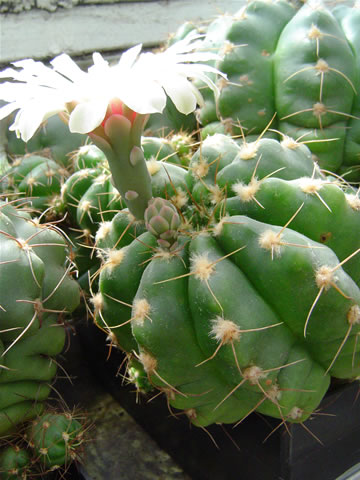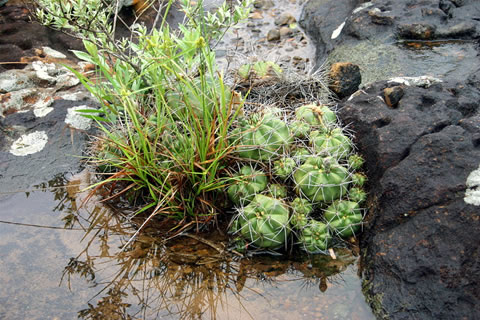Die Cactaceae III, 1701, 1959
Basionym: Gymnocalycium fleischerianum Jajó BfK, 1936
Synonyma: Echinocactus denudatus anisitsii hort. Haage et Schmidt, Katalog 1912
Echinocactus denudatus var. andersohnianus Haage jr., MfK 36, 1898
Echinocactus denudatus var. heuschkelianus Haage jr., MfK 1898
Echinocactus denudatus var. meiklejohnianus Haage jr., MfK 1898
Tělo kulovité, leskle světle zelené, temeno prohloubené, 8 stejných zaoblených nehrbolcovatých žeber, silněji se rozšiřujících, nakonec až 35 mm širokých. Areoly kulaté, silně hnědobíle plstnaté, asi 5 mm velké.
Trny asi 20, nikoliv příliš píchavé, skoro štětinovité, na strany odstávající, paprskovité, žlutobílé až hnědé, záhy šedivé, až 25 mm dlouhé, často zprohýbané; střední trny možné rozeznat, ale sotva odlišit.
Květ nálevkovitý, se svítivě růžovým jícnem.
Domovina: Paraguay.

Gymn. fleischerianum
Rostliny tohoto taxonu poprvé objevil a sbíral Schumannův přítel prof. Hassler, který je poslal kolem roku 1895 do Botanické zahrady v Berlíně – Dahlemu. Nový nález brzy vešel ve známost a pro velký zájem poslal další zásilku importů obchodní sběratel Grosse firmě Ferdinand Haage jr. v Erfurtu, které pak sám Haage popsal jako variety Echinocactus denudatus v MfK 1898. Další importy prodávala firma Haage a Schmidt pod jménem Echinocactus denudatus anisitsii. Importní rostliny však byly velmi choulostivé, pomalu odcházely do kaktusového nebe a poslední nepřežily první světovou válku. Další importy dovezl až A.V.Frič a má je uvedeny v katalogu roku 1929 pod jménem Gymn. denudatum var. anisitsii. Poté se čeští gymnofilové shodli, že se jedná o nový druh a Bedřich Jajó sestavil popis, který poslal Backebergovi. Jejich domluva však nebyla zřejmě dokonalá, a tak vyšel pouze německý popis v BfK. Latinský popis tedy uveřejnil Backeberg sám až roku 1959 v Die Cactaceae.
V posledních 10 až 20 letech se roztrhl pytel s taxonomickými zásahy do všech možných taxonů za účelem doplnění popisu stanovit konečně platnost popisu taxonu, někdy za účelem povýšení či snížení úrovně jeho postavení. To neminulo ani Gymn. fleischerianum. Skupina botaniků Metzing, Meregalli, Kiesling, Tosatto a Carmiello v nám málo známé publikaci Candollea roku 2002 uveřejnili práci hodnotící skupinu Gymn. fleischerianum a Gymn. paraguayense, popis Gymn. fleischerianum validovali, neboli učinili jej platným, a zařadili jej jako formu Gymn. paraguayense, tedy podle jejich stanoviska název taxonu zní: Gymn. paraguayense (K. Schum.) Hosseus fa. fleischerianum Meregalli, Metzing et Kiesling. To však nepřijal náš gymnofil ing. Ladislav Vala z Uherského Hradiště (+ 2006) a vytvořil další práci, uveřejněnou v rakouském Gymnocalycium 2003, kde uvedl Gymn. fleischerianum opět na úroveň druhu, tedy konečná kombinace zní: Gymn. fleischerianum (Meregalli, Metzing & Kiesling) Vala. A jsme s tímto taxonem tam, kde jsme byli – ovšem co se změnilo jmen za názvem druhu! Snad další změnou je přírůstek někde v botanickém herbáři, na který za X let sotva kdo vzpomene, nebo o něj zavadí smetákem uklízečka a přehodí cedulky........ Na tomto místě je třeba zdůraznit, že tato publikace je věnována gymnokalyciím z pohledu pěstitele a s ohledem hlavně na užitečnost při pěstování a proto zde nejsou příliš zohledněna přísně botanická hlediska, která vyžadují větší jmenovky, větší sešity pro evidenci, protože taxony zařazené pod „megadruhy“ nelze napsat na jeden řádek, atd.
Rostliny se vyskytují na několika stanovištích ve východní části středního Paraguaye, kde rostou ve velmi vlhkém prostředí s poněkud kyselou reakcí půdy: Chololo-í, Oyopoi, Piraretá, Salto Amambay (vodopád), Ita Moroti, Yhaguy Guazu, aj. Oba příbuzné taxony, tedy Gymn. fleischerianum a Gymn. paraguayense mají několik míst výskytu přibližně v oblasti oválného tvaru dlouhé 30 km ve směru jihozápad – severovýchod, oba taxony nemají zřetelně oddělené areály. Podmínky jsou zde subtropické a je třeba takto rostliny pěstovat – jako Gymn. chiquitanum, chacoense, a také diskokaktusy, tedy velmi teplomilné rostliny, ovšem nesnášející dlouhodobé přeschnutí substrátu. Nejvíce si libují na horní pozici ve skleníku, mírně stíněné, ale s dostatečným přísunem vody.

Gymn. fleischerianum Vos 316 01, foto Volker Schädlich
Gymn. fleischerianum – summary:
Schumann´s friend prof. Hassler had found and collected at first the plants of the taxon, and he sent them round the year 1895 to the Botanic Garden in Berlin-Dahlem. New find has been soon well-known and for the sake of the great interest the business collector Grosse had sent another consignment of imported plants to the firm of Ferdinand Haage jun. in Erfurt, and they had been described by Haage alone like the varieties of Echinocactus denudatus in MfK 1898. The firm of Haage and Schmidt had sold the other imports under the name Echinocactus denudatus anisitsii. However, the imported plants had been very sensitive, they have slowly went away to the cactus sky and the last ones had not lived over the WW I. The other imports had been brought only by A.V.Frič and he has mentioned them in the 1929 catalogue under the name Gymn. denudatum var. anisitsii. Czech gymnofils had decided later that it has been a new sort and Mr. Bedřich Jajó had written the description, which he had sent to Backeberg. However, their agreement had not been evidently good, so only German description had appeared in BfK. Then Backeberg published the Latin description alone only in 1959 in Die Cactaceae.
The serie with the taxonomic interferences into all possible taxa was started in the past 10 till 20 years with the interest of the determining endly the validity of the taxon description, sometime with the purpose of the raising or the bringing down of its level. It has not passed also Gymn. fleischerianum. The botanic group Metzing, Meregalli, Kiesling, Tosatto and Carmiello published in only little known journal Candollea in 2002 the work evaluating the group of Gymn. fleischerianum and Gymn. paraguayense, they valided the description of Gymn. fleischerianum and rowed it like the form of Gymn. paraguayense, then the name of the taxon after their opinion sounds: Gymnocalycium paraguayense (K.Schum.) Hosseus fa. fleischerianum Meregalli, Metzing et Kiesling. However, it has not been accepted by our gymnofil ing. Ladislav Vala from Uherské Hradiště (+2006) and he made another work in the Austrian Gymnocalycium 2003, where he stated Gymn. fleischerianum on the sort level again, then the end combination sounds: Gymn. fleischerianum (Meregalli, Metzing et Kiesling) Vala. And so we are with this taxon there, where we have already been – however, how many names have changed behind the sort name! The other change is maybe some accretion somewhere in any botanic herbarium, which anybody during X years hardly remembers, or a charwoman will touch it with a brush and turn etikets............... It is necessary to accent here that these publication is inscribed to gymnos mainly of the grower sight and with regard mainly for trhe usefulness in the growing and therefore there are not too regarded the strictly botanic points of view here, which need bigger labels, bigger register books because the taxa rowed under the „megasorts“ are not possible to write to only one line, etc.
The plants occur on several finding places in the east part of the central Paraguay, where they grow in very moist environment with rather acid soil: Chololo-í, Oyopoi, Piraretá, Salto Amambay (waterfall), Ita Moroti, Yhaguy Guazu, etc. The conditions are here subtropis and it is necessary to grow the plant like this – like Gymn. chiquitanum, chacoense, and also discocacti, then very warm loving plants, however, which do not like dry soil during a long time. They love the most the upper position in the greenhouse but with the proper water feed.
